December 12, 2023
At the December 2023 CREATE Research Showcase, students from CSE 493 and other CREATE researchers shared their work with faculty, students, and community partners.
Projects included an analysis of the accessibility of transit stations and a tool to aid navigation within transit stations; an app to help colorblind people of color pick makeup; and consider the accessibility of generative AI while also considering ableist implications of limited training data.
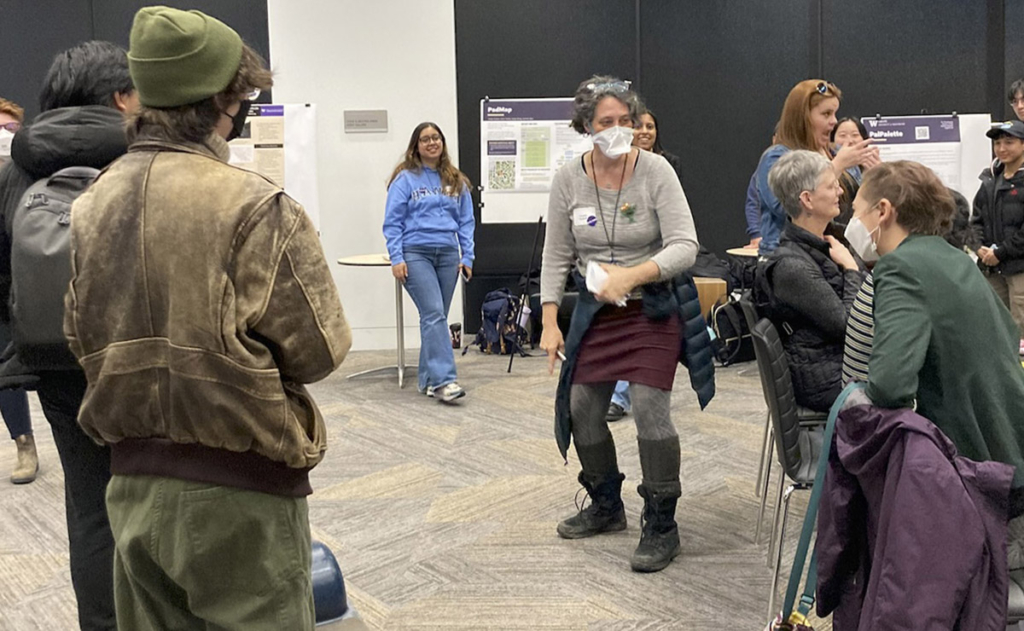
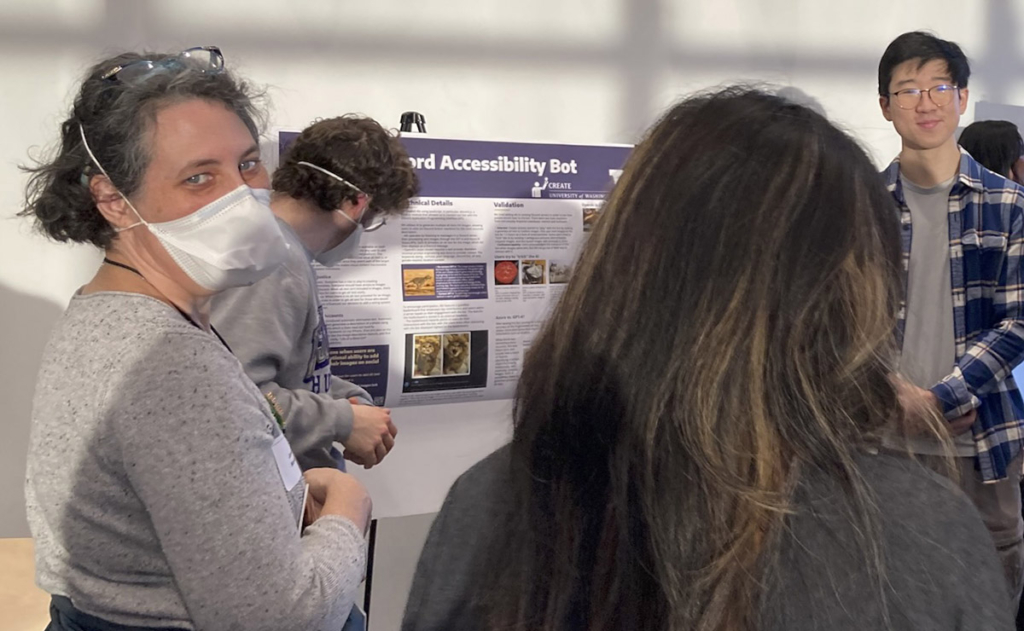
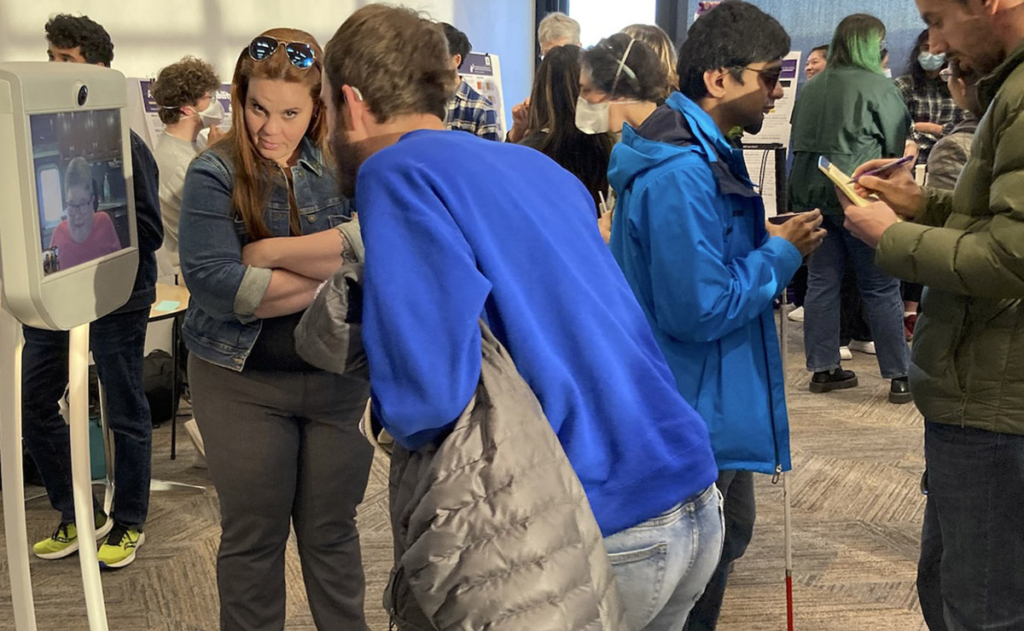
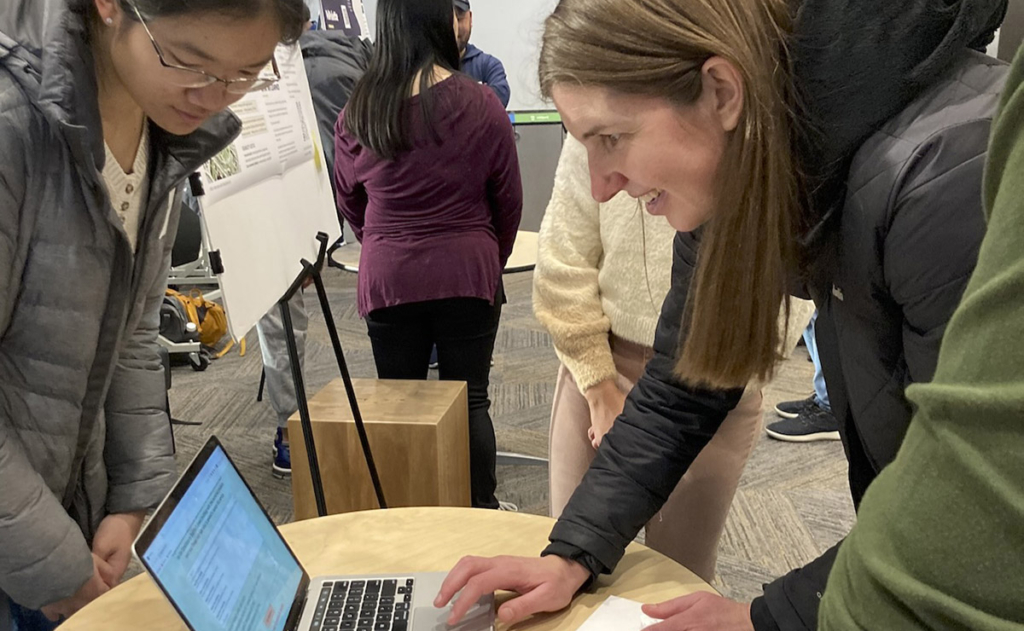
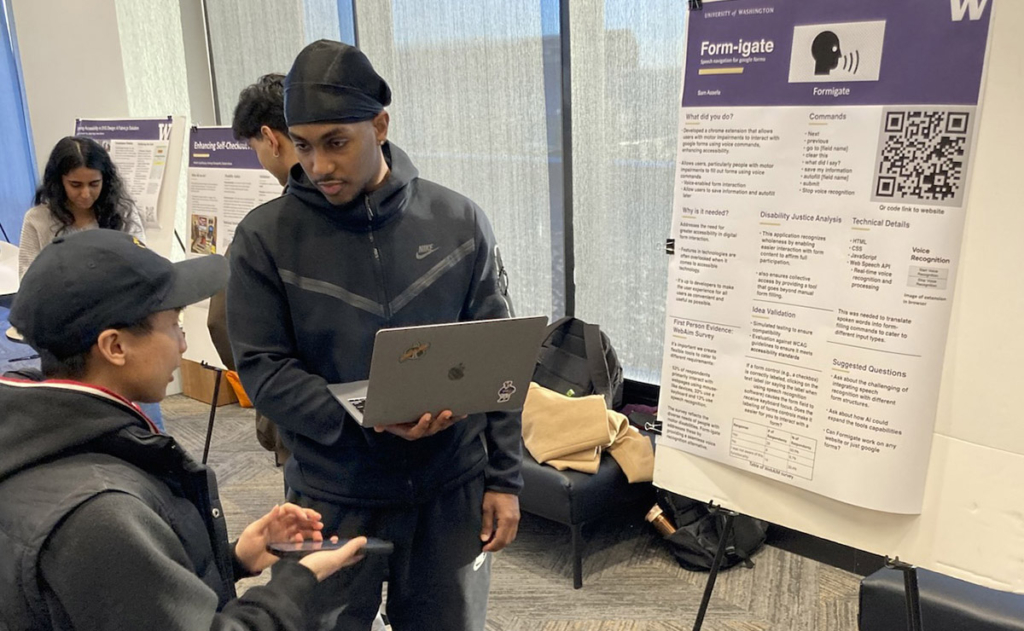
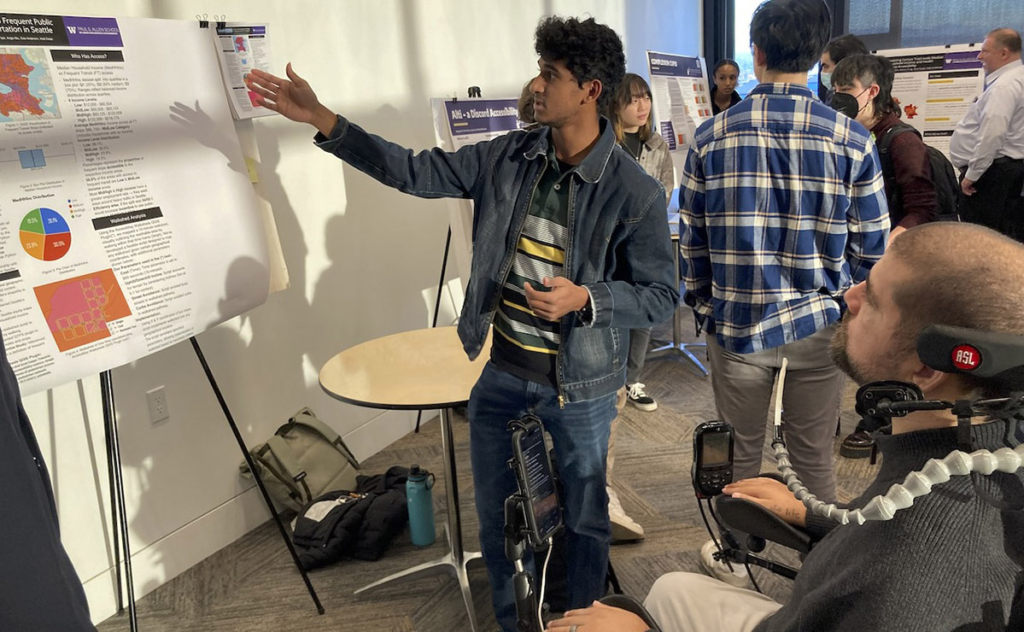
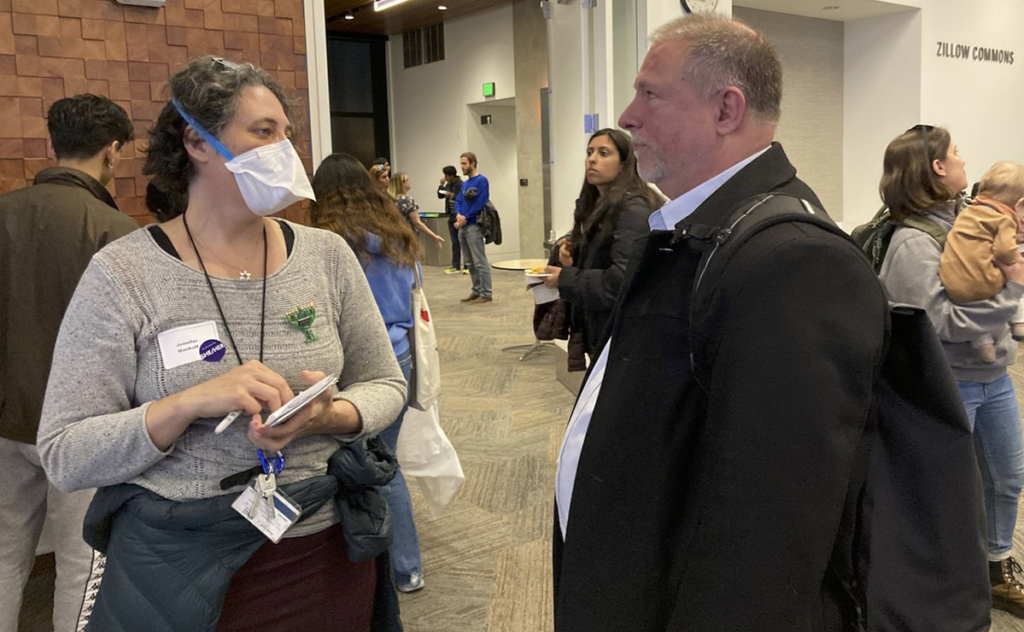
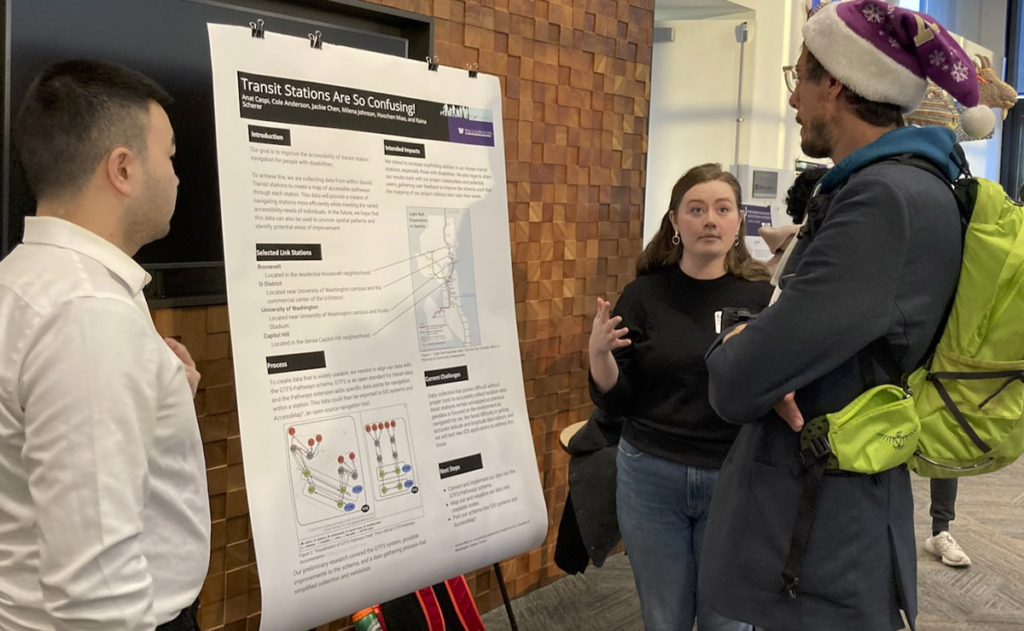
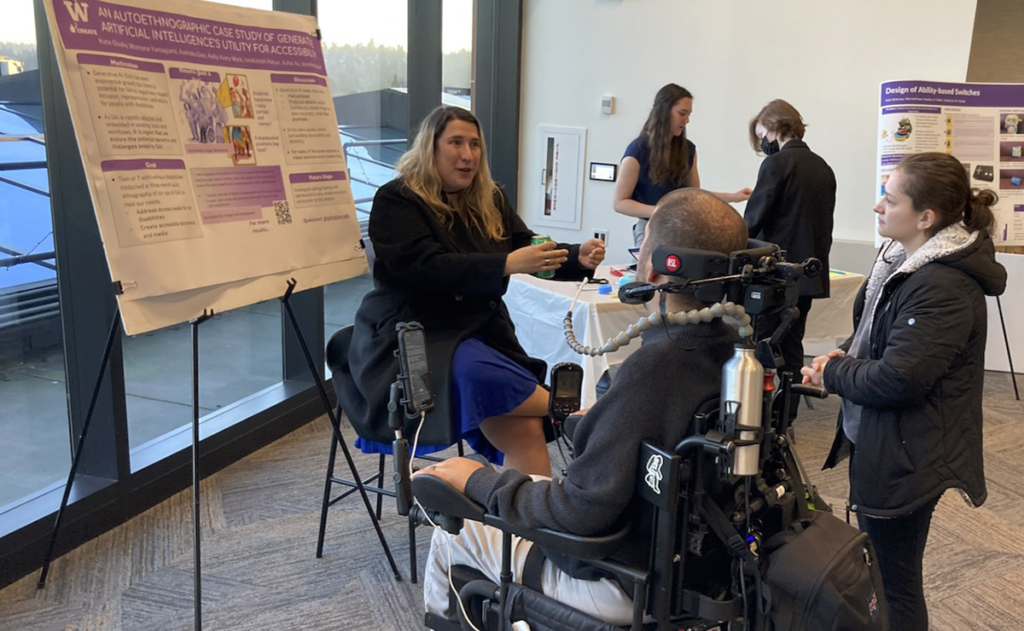
CSE 493 student projects
In it’s first offering Autumn quarter 2023, CSE’s undergraduate Accessibility class has been focusing on the importance of centering first-person accounts in disability-focused technology work. Students worked this quarter on assignments ranging from accessibility assessments of county voting systems to disability justice analysis to open-ended final projects.
Alti Discord Bot »
Keejay Kim, Ben Kosa, Lucas Lee, Ashley Mochizuki
Alti is a Discord bot that automatically generates alt text for any image that gets uploaded onto Discord. Once you add Alti to your Discord server, Alti will automatically generate alt text for the image using artificial intelligence (AI).
Enhancing Self-Checkout Accessibility at QFC »
Abosh Upadhyaya, Ananya Ganapathi, Suhani Arora
Makes self-checkout more accessible to visually impaired individuals
Complexion Cupid: Color Matching Foundation Program »
Ruth Aramde, Nancy Jimenez-Garcia, Catalina Martinez, Nora Medina
Allows individuals with color blindness to upload an image of their skin, and provides a makeup foundation match. Additionally, individuals can upload existing swatches and will be provided with filtered photos that better show the matching accuracy.
Twitter Content Warnings »
Stefan D’Souza, Aditya Nair
A chrome extension meant to be used in conjunction with twitter.com in order to help people with PTSD
Lettuce Eat! A Map App for Accessibly Dietary Restrictions »
Arianna Montoya, Anusha Gani, Claris Winston, Joo Kim
Parses menus on restaurants’ websites to provide information on restaurants’ dietary restrictions to support individuals with specific dietary requirements, such as vegan vegetarian, and those with Celiac disease.
Form-igate »
Sam Assefa
A chrome extension that allows users with motor impairments to interact with google forms using voice commands, enhancing accessibility.
Lite Lingo: Plain Text Translator »
Ryan Le, Michelle Vu, Chairnet Muche, Angelo Dauz
A plain text translator to help individuals with learning disabilities
Matplotalt: Alt text for matplotlib figures »
Kai Nailund
[No abstract]
PadMap: Accessible Map for Menstrual Products »
Kirsten Graham, Maitri Dedhia, Sandy Cheng, Aaminah Alam
Our goal is to ensure that anywhere on campus, people can search up the closest free menstrual products to them and get there in an accessible way.
SCRIBE: Crowdsourcing Scientific Alt Text »
Sanjana Chintalapati, Sanjana Sridhar, Zage Strassberg-Phillips
A prototype plugin for arXiv that adds alt text to requested papers via crowdwork.
PalPalette »
Pu Thavikulwat, Masaru Chida, Srushti Adesara, Angela Lee
A web app that helps combat loneliness and isolation for young adults with disabilities
SpeechIT »
Pranati Dani, Manasa Lingireddy, Aryan Mahindra
A presentation speech checker to ensure a user’s verbal speech during presentation is accessible and understandable for everyone.
Enhancing Accessibility in SVG Design: A Fabric.js Solution »
Julia Tawfik, Kenneth Ton, Balbir Singh, Aaron Brown
A Laser Cutter Generator’ interface which displays a form to select shapes and set dimensions for SVG creation.
CREATE student and faculty projects
Designing and Implementing Social Stories in Technology: Enhancing Collaboration for Parents and Children with Neurodiverse Needs
Elizabeth Castillo, Annuska Zolyomi, Ting Zhou
Our research project, conducted through interviews in Panama, focuses on the user-centered design of technology to enhance autism social stories for children with neurodiverse needs. We aim to improve collaboration between parents, therapists, and children by creating a platform for creating, sharing, and tracking the usage of social stories. While our initial research was conducted in Panama, we are eager to collaborate with individuals from Japan and other parts of the world where we have connections, to further advance our work in supporting neurodiversity.
An Autoethnographic Case Study of Generative Artificial Intelligence’s Utility for Accessibility
Kate S Glazko, Momona Yamagami, Aashaka Desai, Kelly Avery Mack, Venkatesh Potluri, Xuhai Xu, Jennifer Mankoff
With the recent rapid rise in Generative Artificial Intelligence (GAI) tools, it is imperative that we understand their impact on people with disabilities, both positive and negative. However, although we know that AI in general poses both risks and opportunities for people with disabilities, little is known specifically about GAI in particular. To address this, we conducted a three-month autoethnography of our use of GAI to meet personal and professional needs as a team of researchers with and without disabilities. Our findings demonstrate a wide variety of potential accessibility-related uses for GAI while also highlighting concerns around verifiability, training data, ableism, and false promises.
Machine Learning for Quantifying Rehabilitation Responses in Children with Cerebral Palsy
Charlotte D. Caskey, Siddhi R. Shrivastav, Alyssa M. Spomer, Kristie F. Bjornson, Desiree Roge, Chet T. Moritz, Katherine M. Steele
Increases in step length and decreases in step width are often a rehabilitation goal for children with cerebral palsy (CP) participating in long-term treadmill training. But it can be challenging to quantify the non-linear, highly variable, and interactive response to treadmill training when parameters such as treadmill speed increase over time. Here we use a machine learning method, Bayesian Additive Regression Trees, to show that there is a direct effect of short-burst interval locomotor treadmill training on increasing step length and modulating step width for four children with CP, even after controlling for cofounding parameters of speed, treadmill incline, and time within session.
Spinal Stimulation Improves Spasticity and Motor Control in Children with Cerebral Palsy
Victoria M. Landrum, Charlotte D. Caskey, Siddhi R. Shrivastav, Kristie F. Bjornson, Desiree Roge, Chet T. Moritz, Katherine M. Steele
Cerebral palsy (CP) is caused by a brain injury around the time of birth that leads to less refined motor control and causes spasticity, a velocity dependent stretch reflex that can make it harder to bend and move joints, and thus impairs walking function. Many surgical interventions that target spasticity often lead to negative impacts on walking function and motor control, but transcutaneous spinal cord stimulation (tSCS), a novel, non-invasive intervention, may amplify the neurological response to traditional rehabilitation methods. Results from a 4-subject pilot study indicate that long-term usage of tSCS with treadmill training led to improvements in spasticity and motor control, indicating better walking function.
Adaptive Switch Kit
Kate Bokowy, Mia Hoffman, Heather A. Feldner, Katherine M. Steele
We are developing a switch kit for clinicians and parents to build customizable switches for children with disabilities. These switches are used to help children play with computer games and adapted toys as an early intervention therapy.
Developing a Sidewalk Improvement Cost Function
Alex Kirchmeier, Cole Anderson, Anat Caspi
In this ongoing project, I am developing a Python script that uses a sidewalk issues dataset to determine the cost of improving Seattle’s sidewalks. My intention is to create a customizable function that will help users predict the costs associated with making sidewalks more accessible.
Exploring the Benefits of a Dynamic Harness System Using Partial Body Weight Support on Gross Motor Development for Infants with Down Syndrome
Reham Abuatiq, PT, MSc1; Mia Hoffman, ME, BSc2; Alyssa Fiss, PT, PhD3; Julia Looper, PT, PhD4; & Heather Feldner, PT, PhD, PCS1,5,6
We explored the benefits of a Dynamic Harness System Using Partial Body Weight Support (PBWS) within an enriched play environment on Gross Motor Development for Infants with Down Syndrome using randomized cross over study design. We found that the effectiveness of the PBWS harness system on gross motor development was clearly evident. The overall intervention positively affected activity levels, however, the direct impact of the harness remains unclear.
StreetComplete for Better Pedestrian Mapping
Sabrina Fang, Kohei Matsushima
StreetComplete is a gamified, structured, and user-friendly mobile application for users to improve OpenStreetMap data by completing pilot quests. OpenStreetMap is an open-source, editable world map created and maintained by a community of volunteers. The goal of this research project is to design pilot quests in StreetComplete to accurately collect information about “accessibility features,” such as sidewalk width and the quality of lighting, to improve accessibility for pedestrian mapping.
Transit Stations Are So Confusing!
Jackie Chen, Milena Johnson, Haochen Miao, and Raina Scherer
We are collecting data on the wayfinding nodes in four different Sound Transit light rail stations, and interpreting them through the GTFS-pathways schema. In the future, we plan on visualizing this information through AccessMaps such that it can be referenced by all users.
Optimizing Seattle Curbside Disability Parking Spots
Wendy Bu, Cole Anderson, Anat Caspi
The project is born out of a commitment to enhance the quality of life for individuals with disabilities in the city of Seattle. The primary objective is to systematically analyze and improve the allocation and management of curbside parking spaces designated for disabled individuals. By improving accessibility for individuals with disabilities, the project contributes to fostering a more equitable and welcoming urban environment.
Developing Accessible Tele-Operation Interfaces for Assistive Robots with Occupational Therapists
Vinitha Ranganeni, Maya Cakmak
The research is motivated by the potential of using tele-operation interfaces with assistive robots, such as the Stretch RE2, to enhance the independence of individuals with motor limitations in completing activities of daily living (ADLs). We explored the impact of customization of tele-operation interfaces and a deployed the Stretch RE2 in a home for several weeks facilitated by an occupational therapist and enabled a user with quadriplegia to perform daily activities more independently. Ultimately, this work aims to empower users and occupational therapists in optimizing assistive robots for individual needs.
HuskyADAPT: Accessible Design and Play Technology
HuskyADAPT Student Organization
HuskyADAPT is a multidisciplinary community at the University of Washington that supports the development of accessible design and play technology. Our community aims to initiate conversations regarding accessibility and ignite change through engineering design. It is our hope that we can help train the next generation of inclusively minded engineers, clinicians, and educators to help make the world a more equitable place.
A11yBoard for Google Slides: Developing and Deploying a Real-World Solution for Accessible Slide Reading and Authoring for Blind Users
Zhuohao (Jerry) Zhang, Gene S-H Kim, Jacob O. Wobbrock
Presentation software is largely inaccessible to blind users due to the limitations of screen readers with 2-D artboards. This study introduces an advanced version of A11yBoard, initially developed by Zhang & Wobbrock (CHI2023), which now integrates with Google Slides and addresses real-world challenges. The enhanced A11yBoard, developed through participatory design including a blind co-author, demonstrates through case studies that blind users can independently read and create slides, leading to design guidelines for accessible digital content creation tools.
“He could go wherever he wanted”: Driving Proficiency, Developmental Change, and Caregiver Perceptions following Powered Mobility Training for Children 1-3 Years with Disabilities
Heather A. Feldner, PT, MPT, PhD; Anna Fragomeni, PT; Mia Hoffman, MS; Kim Ingraham, PhD; Liesbeth Gijbels, PhC; Kiana Keithley, SPT; Patricia K. Kuhl, PhD; Audrey Lynn, SPT; Andrew Meltzoff, PhD; Nicole Zaino, PhD; Katherine M. Steele, PhD
The objective of this study was to investigate how a powered mobility intervention for young children (ages 1-3years) with disabilities impacted: 1) Driving proficiency over time; 2) Global developmental outcomes; 3) Learning tool use (i.e., joystick activation); and 4) Caregiver perceptions about powered mobility devices and their child’s capabilities.
Access to Frequent Transit in Seattle
Darsh Iyer, Sanat Misra, Angie Niu, Dr. Anat Caspi, Cole Anderson
The research project in Seattle focuses on analyzing access to public transit, particularly frequent transit stops, by considering factors like median household income. We scripted in QGIS, analyzed walksheds, and examined demographic data surrounding Seattle’s frequent transit stops to understand the equity of transit access in different neighborhoods. Our goal was to visualize and analyze the data to gain insights into the relationship between transit access, median household income, and other demographic factors in Seattle.
Health Service Accessibility
Seanna Qin, Keona Tang, Anat Caspi, Cole Anderson
Our research aims to discover any correlation between median household income and driving duration from census tracts to the nearest urgent care location in the Bellevue and Seattle region
Conveying Uncertainty in Data Visualizations to Screen-Reader Users Through Non-Visual Means
Ather Sharif, Ruican Zhong, and Yadi Wang
Incorporating uncertainty in data visualizations is critical for users to interpret and reliably draw informed conclusions from the underlying data. However, visualization creators conventionally convey the information regarding uncertainty in data visualizations using visual techniques (e.g., error bars), which disenfranchises screen-reader users, who may be blind or have low vision. In this preliminary exploration, we investigated ways to convey uncertainty in data visualizations to screen-reader users.